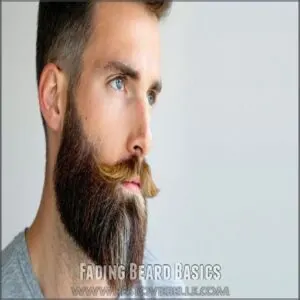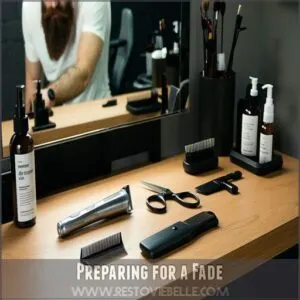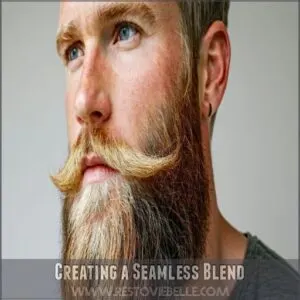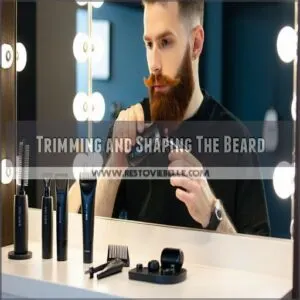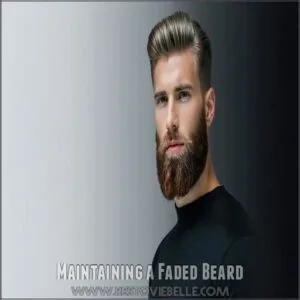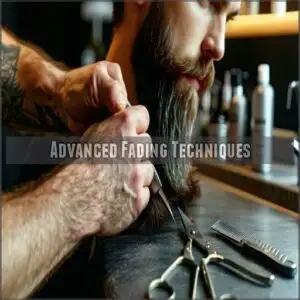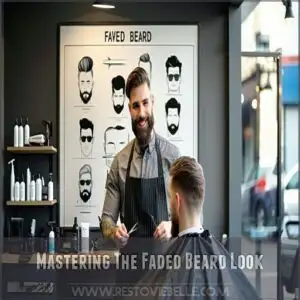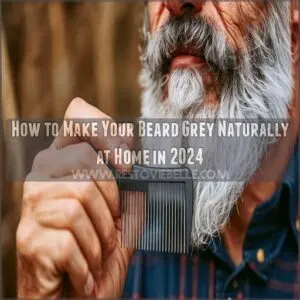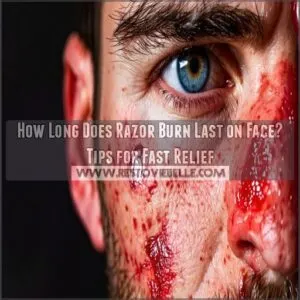This site is supported by our readers. We may earn a commission, at no cost to you, if you purchase through links.
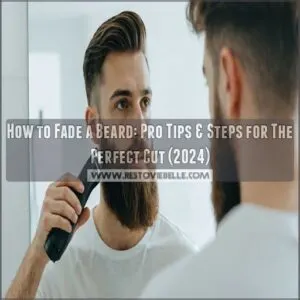 Fading a beard is all about creating a seamless progression from shorter hair near the sides of your face to fuller growth below. Start with clean, dry hair—it’s like painting on a fresh canvas.
Fading a beard is all about creating a seamless progression from shorter hair near the sides of your face to fuller growth below. Start with clean, dry hair—it’s like painting on a fresh canvas.
Use a trimmer with a high guard to trim the top edges, then gradually switch to lower guards as you move downward. Blend using upward scooping motions for a smooth, natural fade.
Check symmetry in the mirror because balance is key. Sharpen your neckline and clean up stray hairs for that polished finish. Mastering how to fade a beard lets you look sharp without breaking a sweat!
Table Of Contents
Key Takeaways
- Start with clean, dry hair and use a trimmer with adjustable guards, moving from longer to shorter lengths for a seamless fade.
- Focus on symmetry by checking in the mirror regularly and use upward motions to blend the neckline and sideburns.
- Maintain your fade with weekly trims, beard oil for hydration, and proper skin care to prevent irritation and ingrown hairs.
- Customize your fade to fit your face shape and style, experimenting with different fade designs and blending techniques.
Fading Beard Basics
You’ll transform your beard from scruffy to stylish with a fade, which creates a smooth shift from longer facial hair to shorter or clean-shaven areas.
Whether you’re new to beard grooming or looking to upgrade your style, mastering the basics of beard fading will help you achieve that clean, professional look you want.
What is a Faded Beard
Ever wondered what sets a faded beard apart from regular facial hair styles? A beard fade creates a seamless blend from your sideburns to your full beard, blending different lengths for a polished look.
Here’s what makes it unique:
- Gradual tapering from shorter hair near the ears to fuller growth below
- Precise trimming that follows your face’s natural contours
- Professional grooming technique that works with various hair textures
- Customizable fade patterns to match your preferred beard styles
To achieve this look, mastering the beard fading technique is essential for a seamless blend.
This modern grooming approach combines traditional beard care with contemporary fading techniques, giving you complete control over your facial hair’s appearance.
Benefits of Fading a Beard
A faded beard does more than just look sharp – it’s your ticket to Enhanced Appearance and Boosted Confidence.
When you master beard fading techniques, you’ll get better Facial Definition that highlights your best features.
Plus, proper beard maintenance during fading actually helps with Skin Protection by preventing ingrown hairs and irritation.
Whether you’re aiming for a Youthful Look or wanting to stand out, fade beard styles offer that perfect blend of polish and personality.
Face Shapes Suitable for Faded Beards
Throughout all face shapes, a well-executed beard fade can enhance your natural features. The key is matching the fade style to your facial structure.
Whether you’ve got a square jaw or heart-shaped face, there’s a perfect beard fade waiting for you.
- Oval faces rock any beard fade style, from short to long gradations
- Round faces benefit from angular faded sides to create definition
- Square jaws look sharp with gradual taper fades that soften edges
- Triangular faces shine with fuller chin areas and tight side fades
How to Fade a Beard
Learning how to fade your beard at home can give your facial hair a sharp, polished look. Here’s a simple beard fade guide:
- Start with clean, dry hair: Wash and pat your beard dry for better control.
- Trim from top to bottom: Begin with a high guard on your trimmer and gradually lower settings.
- Blend carefully: Use upward scooping motions to smooth fading beard lines.
- Focus on symmetry: Check your progress in the mirror to confirm balanced Beard Styling.
To achieve a defined look, mastering the beard fading techniques is essential for a sharp, polished appearance.
Preparing for a Fade
Getting your beard ready for a fade starts with trimming and maintaining a clean base.
Make sure you’ve got the right tools and a tidy workspace to keep the process smooth and precise.
Routine Trimming and Maintenance
Regular beard trimming is the backbone of fade maintenance. Start with shears to even out your beard length, then follow up with a trimmer for precision.
Weekly trimming keeps your look sharp and avoids overgrowth.
Don’t skip skin care—apply a moisturizer after shaving to prevent irritation. Beard products like oils will soften hair, making trimming a beard easier.
To master the beard fade technique, practice and patience are essential for achieving a seamless shift from long to short hair. Consistency guarantees a polished fade technique every time.
Choosing The Right Trimmer and Tools
A great beard fade starts with the right beard trimmer. Choose one with adjustable length combs for smooth shifts. Prioritize blade quality to guarantee clean cuts and avoid tugging.
Cordless options offer flexibility, while trimmer settings let you customize the length. Don’t forget maintenance—cleaning and oiling your beard fade tool guarantees longevity.
Accessories like guards and a storage case keep everything organized and make at-home fades effortless. For more information on achieving a well-groomed look, visit the beard trimming guide.
Setting Up Your Workspace
Before you grab your beard fade tool, set up your workspace right.
Start with good lighting—nobody wants uneven fades from shadows.
Keep your tools, like trimmers, length guards, and adjustable combs, organized and within reach.
Sanitize equipment for a clean shave.
Use a sturdy chair for comfort and control.
Pay attention to trimmer settings, so you’re ready for smooth adjustments.
Having the right beard fade tool is essential for a professional finish.
A prepared space guarantees pro-level results every time.
Fading Techniques and Tips
Mastering the right fading technique is key to achieving a polished and seamless beard style.
With careful trimming, steady hands, and attention to detail, you’ll create a smooth blend that transforms your look.
Fading The Neckline and Sideburns
When fading the neckline and sideburns, precision matters. Start by setting a clear neckline using a bare blade, connecting the middle of your neck to your ears.
To achieve a seamless beard fade technique, choosing the right tools and practicing regularly is key.
- Trim below the neckline with a lower guard.
- Use upward strokes to blend the neckline smoothly.
- For sideburn shaping, start mid-ear and work upwards using descending guard sizes.
- Recheck for even skin blending.
Creating a Seamless Blend
To nail that seamless blend, focus on gradual Beard Layering by adjusting trimmer guards step-by-step.
Start with longer lengths, trimming in even strokes, and work your way down to shorter settings. Use light, consistent passes for smooth Hair Blending that avoids harsh lines.
The goal? A tapered fade that looks effortless. Mastering these Fade Techniques guarantees a Natural Look, giving your beard fade an edge without looking overdone.
Trimming and Shaping The Beard
Shaping your beard is about precision and patience. Use a sharp beard trimmer to sculpt clean edges and maintain symmetry. Start shaping at the neckline for a smooth foundation, then outline the cheek area.
Investing in a good beard trimmer can make all the difference in achieving the perfect fade.
- Trim shorter near fade boundaries for a modern beard fade.
- Comb evenly to spot uneven areas.
- Use shaping tools to guide lines.
- Mind hair texture for smoother lines.
- Always trim in good lighting.
Maintaining a Faded Beard
Keeping your faded beard sharp takes regular care, but it’s simpler than you think with the right routine.
With weekly trims, proper shaving techniques, and a bit of moisturizer, you’ll maintain that clean, polished look effortlessly.
Weekly Trimming and Grooming
Keeping your faded beard sharp means sticking to a weekly trimming routine. Start by washing and drying your facial hair—clean beards are easier to manage. Use quality trimming tools with adjustable guards to maintain your desired beard length.
Stick to a consistent method: higher guards for the sides and lower guards for the fade. Comb through your beard first to spot uneven patches. Pay attention to grooming tips like shaping the neckline and sideburns evenly for a polished look.
To master the beard fade techniques, understanding how different tools and methods work together is key. Beard care tips also include applying beard oil after trimming to hydrate your skin and keep your beard fade looking smooth.
Preventing Ingrown Hairs and Razor Burn
A smooth fade starts with mastering the art of avoiding bumps and irritation. Prep your sensitive skin with proper exfoliation methods—use a gentle scrub a few times a week to prevent ingrown hairs.
Before touching a razor, warm things up with hot water or a towel to open pores. Stick to shaving techniques that work: a sharp, clean razor is non-negotiable. Always shave with the grain and avoid going over the same spot repeatedly.
To minimize razor burn issues, consider adjusting your shaving routine. Wrap it up with aftercare routines like a cooling moisturiser for skin soothing and reducing redness. Bonus: razor maintenance keeps everything sharp and irritation-free.
Advanced Fading Techniques
When you’re ready to take your beard game to the next level, advanced fading techniques help you achieve a seamless, professional finish.
These methods focus on flawless shifts and precise detailing, perfect for tackling challenging styles like blending into a bald head or shaping a bold beard.
Fading a Beard Into a Bald Head
Blending a beard into a bald head takes precision and patience. Start with proper skin preparation—clean and moisturized skin helps the clippers glide smoothly.
Use the lowest guard to begin fading the sideburns, shaving upward. Gradually switch guards for a seamless skin fade. Pay attention to hair texture and beard length for a balanced look.
A tapered beard complements this fade haircut, creating a polished, confident bald head shift. To achieve the perfect fade, understanding faded beard styles is vital for a natural-looking blend of facial hair and skin.
Creating a Sculpted Big Beard
Sculpting a big beard means balancing boldness with precision.
Start with a beard trimmer and use longer guards to define the bulk.
Gradually blend into shorter lengths for the perfect beard fade.
Incorporate sharp lines along the cheeks and neckline for a polished look.
Use sculpting techniques to enhance symmetry and fullness.
Beard styling isn’t just shaping—it’s about creating a signature design that complements your facial hair and overall style.
Common Mistakes to Avoid
If you want a sharp beard fade, don’t rush. Over trimming and incorrect trimming can quickly ruin the look, leaving uneven edges or patchy spots. Avoid heavy pressure on clippers—it causes skin irritation or an unbalanced trim.
Watch for over-fading the neckline, which makes your beard appear smaller. To achieve the best results, understanding shaving techniques is essential for a smooth shave.
Stick to gradual shaping and follow proper beard trimming steps. Consistency in tools and technique avoids these common shaving mishaps.
Mastering The Faded Beard Look
Mastering the faded beard look is about creating a clean, seamless blend that suits your style and face shape.
With the right tools and a little practice, you’ll achieve a professional finish that ties your entire appearance together.
Customizing Your Fade
You’ve mastered the techniques, now make your beard fade uniquely yours. Think about your style, texture, and preferences for a personalized look.
- Experiment with fade designs: low fade for a subtle touch, high fade for boldness.
- Blend your beard texture: match length and density to enhance balance.
- Incorporate taper fades: for sleek hair blending that polishes your overall appearance.
Customization takes your beard styling to the next level.
Combining Your Fade With Other Hairstyles
Pairing your beard fade with the right hairstyle transforms your look entirely. A taper fade blends effortlessly into a slicked-back style for polished vibes, while a low fade works wonders with a classic crew cut.
Hair textures and facial structure matter—wavy hair suits a textured quiff, and a high fade complements square faces. To achieve the perfect look, consider exploring beard fade styles that suit your face shape and hair type.
Experiment with style combinations to highlight your features and nail your grooming game.
Tips for a Professional-Looking Fade
To nail that professional beard fade, start with proper skin preparation—clean and moisturize for a smooth trim.
Use precise trimmer settings, working from long to short for a seamless gradient. Focus on beard texture; comb regularly to spot uneven areas.
Pay attention to detail, especially around the neckline and sideburns. Try barber tips like using small, upward strokes for beard shaping. Consistency’s key for sharp, polished results.
Frequently Asked Questions (FAQs)
How do you fade a beard?
Ever wondered if blending beard lengths could sharpen your look?
Start trimming from the neckline with high guard settings, gradually reducing guards toward the cheeks using upward motions.
Blend patiently, and don’t rush perfection.
How to prevent facial hair from growing back?
You can’t permanently stop facial hair growth, but laser hair removal or electrolysis reduces it substantially over time.
Regular waxing or threading slows regrowth too.
Stay consistent with your method for the best results.
What is a beard fade?
A beard fade is like blending colors on a canvas—it graduates hair smoothly from short to long.
This stylish technique shapes sideburns, cheeks, and neckline, balancing precision and creativity for a sharp, polished appearance.
Can You fade a patchy beard?
Yes, you can fade a patchy beard.
Focus on blending the sparse areas with a gradual progression.
Use varying trimmer guards, keep edges clean, and embrace shorter lengths to create a sharper, uniform appearance.
Should a beard be faded?
A faded beard is like a custom suit for your face—it adds polish and sharpens up your look.
Fading blends lengths seamlessly, creating clean lines and elevating your style while complementing almost any face shape.
Can You FreeHand a side Fade a beard?
Freehanding a side fade on a beard is possible but tricky.
It takes a steady hand, patience, and precise trimmer control.
Start with longer guard settings, gradually reduce, and blend carefully for smooth gradations.
How can I fade my beard at home?
Imagine sculpting your beard like an artist shaping clay.
Use a trimmer with adjustable guards, start with longer settings, and gradually lower them.
Blend carefully around the neckline and sideburns for a smooth, sharp change.
How do I taper down my beard?
To taper your beard, start with longer trimmer guard settings at the chin, then gradually switch to shorter guards toward the neckline and cheeks.
Work in sections, use a comb, and blend smoothly for balance.
Can you do a fade with a beard?
70% of men maintain facial hair, and yes, you can totally fade a beard!
Use a trimmer with guards, start with longer lengths, and gradually shorten for a smooth, blended look while maintaining control.
How to lighten a dark beard?
Lighten a dark beard by applying a beard lightening kit or natural remedies like lemon juice.
Blend the product evenly, rinse thoroughly, and moisturize afterward.
Always test for allergies and avoid over-processing to prevent damage.
Conclusion
Mastering how to fade a beard isn’t as hard as it might seem.
With the right tools, a little practice, and attention to detail, you can achieve a clean, sharp look that suits your style.
From blending your neckline to shaping your sideburns, each step adds to a polished result.
Keep up with weekly touch-ups, avoid common mistakes, and experiment to find a fade that works best for you.
Your beard deserves to look its best!

